Cult of Saint George in the Teutonic Order
Almost all the saints who were patrons of the Teutonic Order were women - St. Elizabeth, St. Barbara, St. Dorothea, St. Catherine, St. Margaret and of course the Virgin Mary. Except for one saint - George (the Victorious), revered by both the knights of the Order and ordinary laymen.
According to the calendar in the Order's statutes, created in the mid-13th century, St. George's Day is celebrated on April 23 or the ninth day of the Ides of April [1]. According to the calendar, St. George's Day was considered a memorial day, with nine readings of the breviary (book of hours), like an ordinary holiday. In fact, St. George stood in the same row with other saints whose day is related to the modern rank of ordinary memory in the category of Catholic holidays.
Over time, George began to enjoy increasing respect and veneration in the Order, and became especially popular in Prussia. In the 14th century, St. George's Day became a holiday (duplex) and even a celebration, which can be traced in later editions of the Order's statutes. But, again, only in Prussia.
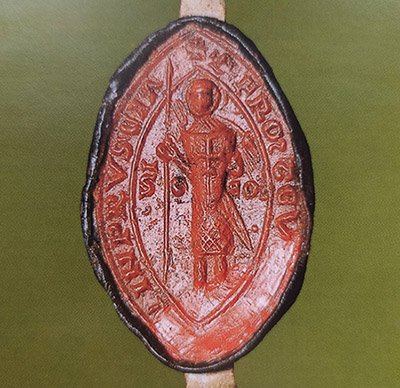
This happened at the beginning of the 14th century, in connection with the military campaigns to Lithuania that became popular among the European nobility. During almost the entire 14th century, guests arrived in Prussia "in honor of God and the pious knight Saint George." At that time, the banner of Saint George was first mentioned in the chronicles - a large banner with an image of a straight red cross on a white field. The right to lead and lead the banner in battle and on campaign was honorable, for which one of the guests of the Order was chosen. Usually these were Franconians or Swabians.
There was also another banner for the guests of the Order, "the second most important" - the banner of the Virgin Mary. It was a large banner, with the image of the figure of the Virgin Mary on a red field. However, there is little information about the banner and its standard-bearers.
The first mention of the St. George banner dates back to 1311 ( Chronica nova Prutenica ), the last – to September 1435 – the defeat of the brothers of the Livonian Order in the Battle of Wilkomir [2] ( LUB VIII.985 ).
Leading the St. George's banner on campaigns and in battle was considered a distinctive, honorable duty, and disputes often arose among guests regarding who would lead the banner.
Peter Suchenwirth [3], a wandering singer who accompanied the Austrian Duke Albrecht on a journey to Prussia, sang of the exploits and adventures of his master in laudatory knightly verses. They contain references to past events that Suchenwirth and the Duke could not have witnessed. Thus, there is a mention of the campaign of Johann (Hans) Count Traun with the St. George's banner and the Livonian Order to White Russia for the siege of Izborsk in 1349 ( SRP II ).
And in the same verse, Suchenwirth calls knighthood “the blessing of St. George.”
In 1361, Henning Schindekopf set out on his first Lithuanian campaign as a marshal. The guests of the order gathered "under the banner of St. George, which was carried by a noble warrior named John de Calmuth" ( Chronica nova Prutenica ).
In the spring of 1362, the banner of St. George, together with other banners of the Order, took part in the siege and storming of Kovno (Kaunas, Lithuania). The banner of St. George was led by Georg von Hirtenberg ( Chronica nova Prutenica ).
In the campaign of the spring of 1363, in which the distinguished guest from France Jean II de Blois-Châtillon took part together with Master von Kniprode, the St. George banner is mentioned, or rather the minstrels from the banner of St. George, with which the Count of Blois paid 1 mark at a feast on April 27 near Veluna.
In 1364, a dispute arose between Ulrich IV von Hanau and the English over who would lead the banner to the siege of Grodno. In the end, the banner was led by Kuno von Hattenstein, the future Grand Marshal of the Order ( Chronica nova Prutenica ).
During the second visit to Prussia by Jean II, Count of Blois in the spring of 1369, another campaign was made in Lithuania, during which Gotteswerder Castle (the area of modern Kaunas, Lithuania) was built on the banks of the Neman. Before the campaign, the Count purchased fabric for the banner of St. George in Königsberg, and a knight from the Count's retinue, someone from the von Gouda and Schonhoven family, headed the St. George banner.
During the Lithuanian campaign of the Austrian Duke Albrecht III in 1377, the already mentioned Suchenwirt sang of his exploits, mentioning, among other things, the battle order of the banners during the invasion of Lithuanian lands, and among them the second was the banner of St. George ( SRP II ).
During the siege of Vilno (Vilnius, Lithuania) by joint Teutonic-Samogitian forces in 1383, the banner was led by the knight Hubert von Sendendorf ( Chronica nova Prutenica ).
In the summer of 1385, a large army led by the Master of the Teutons entered the lands of the Lithuanians. "They entered their land with banners unfurled. The banner of St. George was first, then came the pilgrims, then the banner of the Blessed Virgin and the banner of the Order with the eagle and cross" ( Chronica nova Prutenica ). During the same campaign, military exercises in honor of St. George were held near Medininkai (now Medininkai, Lithuania). It is not entirely clear what exactly the chronicler meant by this phrase, probably some kind of military review or knightly tournament, which was often a part of Lithuanian campaigns.
During the winter Lithuanian campaign of 1390, the banner of St. George was led by the knight from Franconia, Apollinaris Fuchs von Dornheim ( Chronica nova Prutenica ).
During his stay in Prussia in 1390-91, the Earl of Derby, the future Henry IV of England, "disputed much about the banner of St. George; but did not obtain his own" ( Annalista Torunensis ). St. George had been the patron saint of England and chivalry since the time of Richard I, and Henry, as an Englishman and a Knight of the Order of the Garter, could not help but lay claim to the banner of St. George. Because of the disputes that arose, the Master did not abolish the table of honor [4] on that campaign.
In the summer of 1392, the future King of England visited Prussia again. Even before leaving for Prussia, he ordered two St. George pennants for his soldiers. Already in Königsberg, another disagreement arose between the English and the Germans about who would carry the St. George banner. "Although many were against it, they entrusted it to Mr. Rupert von Schockendorf" ( Chronica nova Prutenica ). In response, Henry left Prussia without taking part in the planned campaign. According to his travel accounts, on September 1, 1392, in Elbing (Elbląg, Poland), he made an offering of 1/2 Prussian mark to the Chapel of St. George.
In the autumn of 1392, before the start of the campaign, Marshal Engelhard Rabe laid a table of honour for the guests of the Order in the castle of Johannisburg (Pisz, Poland). At the head of the table was seated the already mentioned Apollinaris Fuchs von Dornheim, who again headed the banner of St. George ( Chronica nova Prutenica ).
In the summer of 1393, the Order’s army, led by Marshal Werner von Tettingen, set out for Lithuania through the Grauden forest [5] – “he sent ahead with the great army the banner of St. George, which was carried by the Franconian, Mr. Johann Niedecker, sending after it the banner of the Holy Virgin” ( Chronica nova Prutenica ).
And in the same year a campaign was launched against Grodno, in which the banner was led by the knight Johann Subener, “a warrior who carried the banner of St. George in enemy territory” ( Chronica nova Prutenica ).
In the winter of 1394, one of the large and distant campaigns of the Order to Lithuania was carried out. Led by the Marshal, the Order's army arrived in Grodno, from where it moved to Novogrudok, from there to Lida, then to Merkina. During this campaign, the troops "did not spare the banner of St. George, but brought countless captives to Prussia" ( Chronica nova Prutenica ). It is implied that the honorary banner of St. George took an active part in the battles.
In the summer of that same year, a large army of the Order, led by Master Conrad von Jungingen, set out to storm Vilnius. "In the order of the banners, as has already been said above, the fourth was the banner of St. George. It was carried by Mr. Eberhard von Enzenberg, and the banner of the Blessed Virgin was carried by Mr. Rutger von de Boetzeler, a Frenchman" ( Chronica nova Prutenica ).
The Bellenville Armorial , created at the end of the 14th century, presents several coats of arms of knights who headed the St. George banner at different times. They are identified by the protruding hand holding the banner of St. George. There are three such coats of arms in the armorial:
- Johann Banritz von Mühlenmark, who headed the St. George Banner during the supposed period of 1350-74;
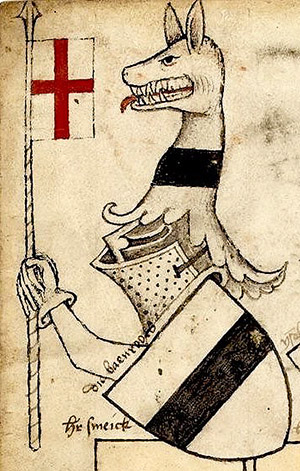
- a certain Ferch von Turnau, in the 1360-70s;
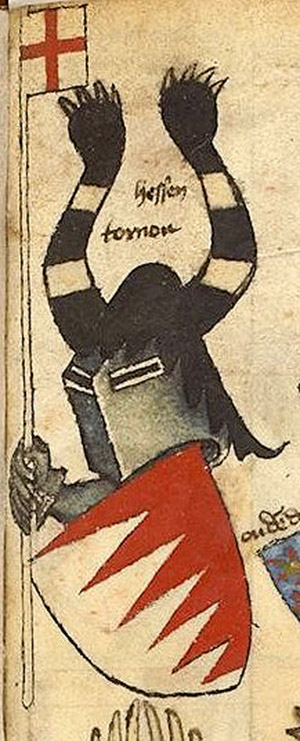
- Johann Kammerer von Worms, in 1379-81.

There are references to the St. George banner in the Marienburg Treasurer's Book ( Marienburger Tresslerbuch ). In the section of the order's trappier (intendant), there are two entries for 1409. The first is for May, about the purchase of "silk taffeta for 8 cattle [6] for the banner of St. George", and the second is for September, about the expenditure of "20 cattle for 5 elens (cubit, approximately 50 cm) of red silk for the banner of St. George" ( MTB ).
A year later, in 1410, the banner of St. George took part in the Battle of Grunwald. The banner was led by the envoy of King Sigismund of Luxembourg [7], the knight Christopher von Gersdorff. In the description of the Prussian banners captured at Grunwald compiled by Dlugosz [8], there is also a "Banner of St. George on the side of the crusaders" ( Banderia Prutenorum ), the image of which does not correspond to the real St. George's banner.
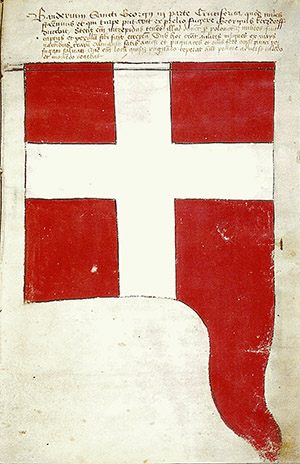
As historian and researcher Sven Ekdahl suggests, the banner, mistakenly called the "St. George's Banner" of the Teutonic Order, was probably the banner of a Hungarian detachment that took part in the battle on the side of the Order's army. It could also have been the banner of Swiss mercenaries fighting in the army of the Teutonic Order.
Another aspect of the activity of the crusader guests in Prussia, in addition to military campaigns, was pilgrimage and charity. Basically, everything was tied to Königsberg, where the residence of the Marshal of the Order was located and where the arriving guests gathered. In the city and suburbs there were many churches and chapels dedicated to various saints, the chapel of St. George was especially respected.
On September 3, 1329, Grand Master Werner von Orseln transferred Georgshof (George's Court, located on the Vorstadt, an area south of Kneiphof Island), located in the suburbs and belonging to the Ermland diocese, to the residents of Königsberg for the creation of a hospital for lepers ( PrUB II.660 ). Thus, a leper colony dedicated to St. George arose outside the city. It is noteworthy that Georgshof and the hospital are mentioned even before their transfer to the city and the creation of a leper colony there. In 1327, in the charter of April 6, granting city rights to the new city of Knipabe (Kneiphof is one of the three cities of Königsberg), a road to St. George is mentioned. Also, cattle belonging to the hospital of St. George were allowed to graze on the pastures granted to the new city. George ( PrUB II.585 ). The gate leading from Altstadt (one of the three cities of Königsberg) across the Lavochny Bridge to Kneiphof and further to the hospital of St. George was also called the Gate of St. George ( PrUB III.223 ).
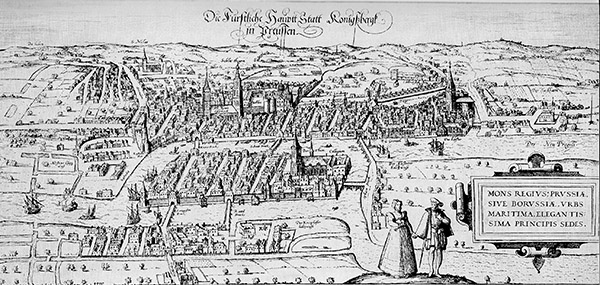
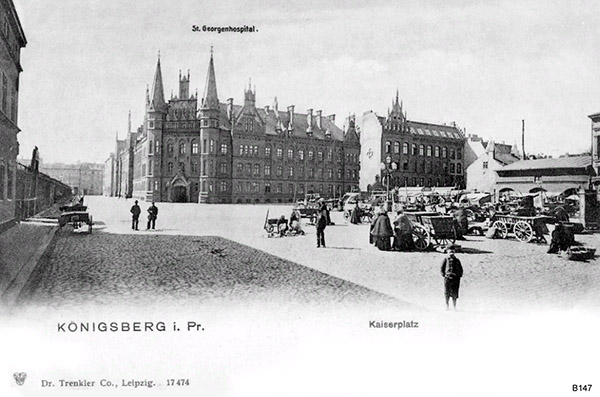
The chapel in this leper hospital was a place of pilgrimage for numerous guests of the Order in the 14th century. In 1333, the city council of Altstadt donated funds for the organization of an eternal lamp in the chapel. On March 7, 1336, European knight guests, as well as eminent citizens, jointly donated an altar to the Church of St. George and established an annual contribution to the church in the amount of 13 Prussian marks ( PrUB III.47 ). The donation was confirmed by the marshal and commander of Königsberg Heinrich Dusemer. Among the donors were the future Margrave of Namur Philip III, Margrave of Brandenburg Ludwig V, cousins Johann and Hermann, Counts of Henneberg and others, from the citizens Eberhard Scriptor allocated 3 marks.
In March 1344, William II the Bold, Count of Holland, attended mass in St. George's Chapel and donated 50 guilders.
In March 1369, the already mentioned Jean de Blois donated to the chapel of St. George, and since everything happened on Good Friday, March 30, the count visited several churches in Königsberg and the church of St. Barbara in Löbenicht (one of the three cities of Königsberg) and the cathedral in Kneiphof also received donations. The count also ordered and paid for 50 heraldic panels, which were placed in the chapel.
Leper colonies with chapels of St. George also existed in other cities of the Order's Prussia - this is the already mentioned chapel of St. George in Elbing, as well as chapels in Danzig (Gdansk, Poland), Kulm (Chelmno, Poland), Thorn (Torun, Poland) and Marienburg (Malbork, Poland).
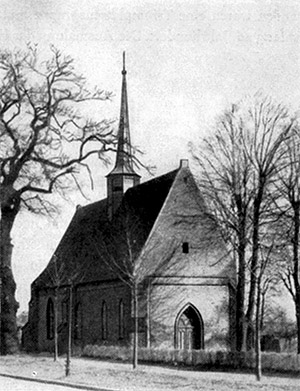
In addition to the chapels, 12 churches were dedicated to St. George in Prussia. Among them are churches in Rastenburg (Kętrzyn, Poland), Bartenstein (Bartoszyce, Poland), Friedland (Pravdinsk, Russia), and Rehden (Radzyń-Chelmiński, Poland).
Two castles were also named in honor of Saint George:
— Georgenburg on Inster (Maevka settlement, included in Chernyakhovsk, Russia),
founded in 1337;
— Georgenburg on Memel (Jurbarkas, Lithuania), founded in 1343.
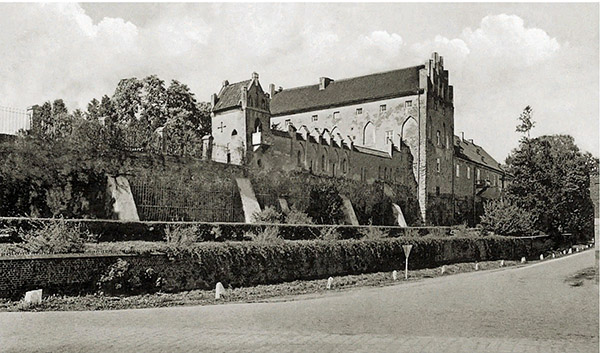
In the Lochstedt castle (Pavlovo, Russia), on the wall of one of the rooms there was a fresco from the end of the 14th century, depicting St. Margaret and St. George. Also, a fragment of a wall painting depicting St. George and the dragon has been preserved in the Schippenbeil church (Sempopol, Poland). Several wooden sculptures of the saint were in churches, for example, the sculpture from the Lorenz church in Marienburg.
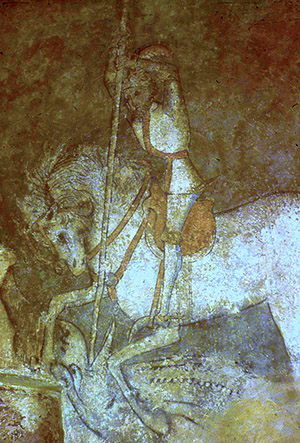
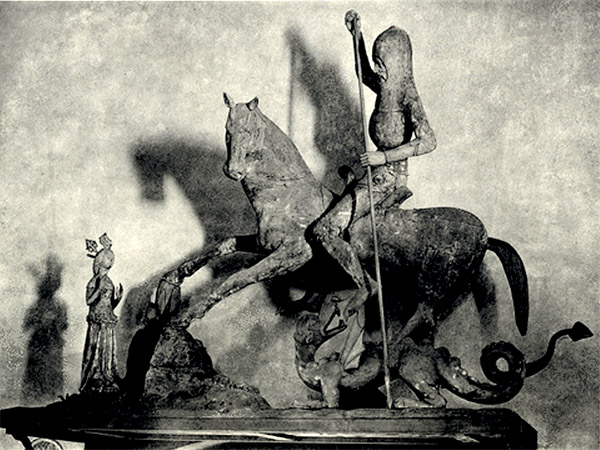
It could be said that the entire 14th century passed in Prussia under the banner of St. George. As Professor Udo Arnold noted, the new ideal patron of the Order was not "Elizabeth dressed in a gray cassock, but George shining in armor."
Over time, the cult of St. George loses its popularity, after the defeat of the Order in the Great War, the Lithuanian campaigns cease. But the name of the saint, which was established at that time, has existed to this day in the names of churches, hospitals and societies.
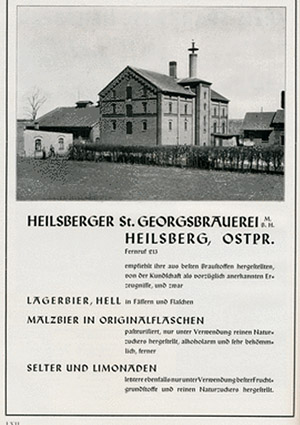
Notes:
1. Ides is the third main day (after Kalends and Nones) in the Roman calendar, the middle of the month, the day of the full moon.
2. The Battle of Wilkomir was a battle between the troops of the Grand Duke of Lithuania Sigismund Keistutovich and the troops of Prince Svidrigailo Olgerdovich during the civil war in the Grand Duchy of Lithuania, which took place on September 1, 1435, near the present-day city of Ukmergė. It ended with the victory of Sigismund's troops. The troops of the Livonian Order fought on the side of Svidrigailo.
3. Peter Suchenwirt (c. 1320 – c. 1395) was an Austrian travelling singer.
4. Table of honor - a knightly tradition, honorary feasts at which 12 valiant and crowned with glory knights were chosen from among the guests, the most honorable was seated at the head of the table.
5. Grauden is a forest located on the border of today’s Neman, Slavsky and Chernyakhovsky districts of the Kaliningrad region.
6. Scot - a monetary unit in the Order of Prussia, 1 Prussian mark = 24 cattle, 1 cattle = 9 grams of silver.
7. Sigismund of Luxembourg (Siegmund I, 1364-1437) - King of Hungary from 1387 (one of the longest-reigning Hungarian kings), King of Germany from September 20, 1410; King of Bohemia from August 16, 1419 to June 7, 1421, Emperor of the Holy Roman Empire from May 3, 1433.
8. Jan Długosz (1415-1480) – Polish historian and diplomat, a major Catholic hierarch, author of the “History of Poland” in 12 volumes.
Sources and literature:
GStA PK, XX. HA, OBA
Living, Eastern and Eastern European Books. Band 8. / becoming a FG v. Bunge, in the Baltic Sea region and the state fortifications of Hermann Hildebrand. Published by J. Deubner: E. F. Steinacker, 1884.
Previous Book of Explanations. Political Abteilung. Bd. I-VI. Königsberg; Marburg, 1882-2000.
Scriptores Rerum Prussicarum . The social changes of the Pre-Russian Empire to the bottom of the military order. Zweiter Band. Hrsg. Theodor Hirsch, Max Töppen, Ernst Strehlke. Frankfurt am Main: Minerva, 1965.
Urkundenbuch des Bisthums Samland , ed. C. P. Woelky, H. Mendthal. Leipzig, 1891–1905.
Arnold U. Elizabeth and George as Patrons of the German Empire. About the Self-Regulations of the German Orders // Elizabeth, the German Order and its Church: Festschr. about 700 hours of work. Weihe d. Elisabeth Church Marburg 1983. Marburg, 1983. S. 163-185.
Ekdahl S. The "Prudent Band" of Jan Dlugosz - a story about a castle in Tannenberg in 1410 / Preparations for the study, preparation and completion of the manual. Gottingen, 1976.
Heckmann D. Fighting for the German Order in Preußen and in the Chamberlain of the Reichs. Werder, 2014.
Joachim E. The Marienburger Treasury of the Years 1399-1409. Königsberg i. Pr.: Verlag von Thomas & Oppermann, 1896.
Kyngeston R. Expeditions to Prussia and the Holy Land made by Henry earl of Derby (after King Henry IV.) in the years 1390-1 and 1392-3. [Westminster]: Printed for the Camden society, 1894.
Nelson P. The stories of St. Georgen Hospital in Königsberg i. Pr. The average price is 600 days. Besties. Reported on Sept. 13. 1329. Königsberg i. Pr., 1929.
Paravicini W. The advancement of European Adels. Part 1. Sigmaringen: Jan Thorbecke Verlag, 1989.
Paravicini W. The advancement of European Adels. Part 2. Band 1. Sigmaringen: Jan Thorbecke Verlag, 1995.
Perlbach M. Quellen-Beiträge z geschichte der Stadt Königsberg im Mittelalter. Göttingen: Robert Peppmüller, 1878.
Perlbach M. Registrar of the City of Königsberg, 1256-1524. Königsberg: Albert Rosbach, 1881.
Perlbach M. The statutes of German orders on the oldest handwritten notes. Hildesheim; New York, 1975.
Probst C. Helfen and Heilen. Hospital, Firm and Research of the German Orders in Preussen until 1525. Studies and Research on the German Orders. Band 29. Bad Godesberg: Wissenschaftliches Archiv, 1969.
Prutz H. Research on Heinrich Derby's Preussenfahrten 1390-91 and 1392. Leipzig: Duncker and Humblot, 1893.
Steinbrecht CE Schloss Lochstedt and his wife: A dream come true for the German newspaper Blues. The construction of the German Railways in Preussen. III. Lochstedt Castle and its mountains. Berlin: Springer, 1910.
Wigand of Marburg . New Prussian Chronicle. Moscow: Russian Panorama, 2014.
